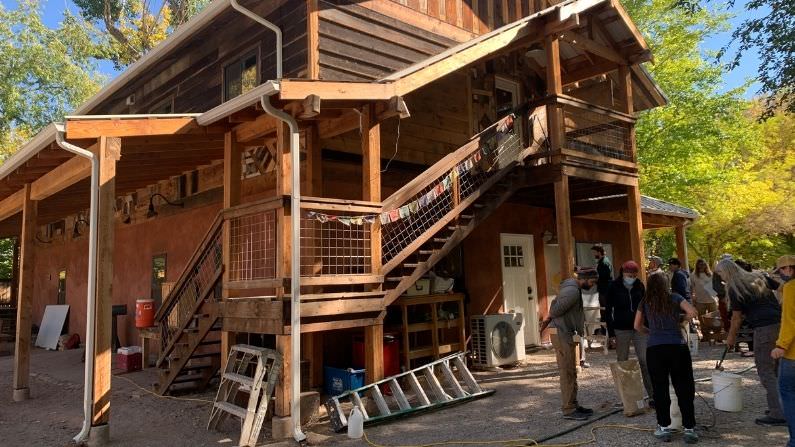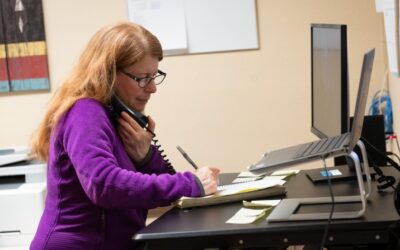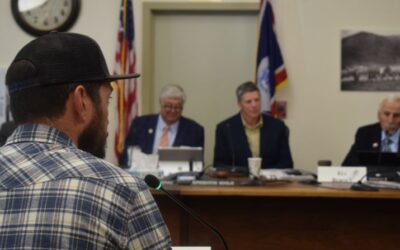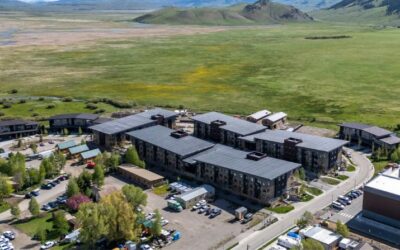At the Community Rebuilds campus in Moab, Utah, they’re hosting events for the Natural Building Conference. That’s a gathering of those interested in construction using materials like straw bale, soil and lime mortar.
Moab has a housing problem, similar to other tourist-orientated towns in the region. Amanda Jane Albert is an instructor here, and calls finding a place to live “unreachable” for a lot of folks.
“There’s lots of service workers here. There’s lots of seasonal people that come in and leave. But the tourist industry and the second-home situation has sort of raised the cost of living beyond reach for most of the workers in Moab,” Albert said.
Housing that is affordable can be trailers or manufactured homes not suited for Moab’s hot summers and cold winters. Albert’s organization solves both problems—providing affordable housing built with material like straw bale that’s inexpensive and energy-efficient. Their intern program also cuts down on labor costs while training the next generation of natural homebuilders.
“One of the benefits of the program here is that we provide a safe, accessible space for anybody who’s interested in construction to come and be on a construction site,” Albert said. “It might be intimidating if you’re not a typical construction worker to walk up to just some construction site and say, ‘Hey, I want to learn.’”
Joah Continentino is an intern in Moab from Tallahassee, Florida. He was interested in natural building, but it can be expensive to learn.
“Something really special about this program is that they do accept people with little to absolutely no experience,” he said. “That’s kind of unheard of to get kind of a foot into the natural building world without going to school.”
Since 2010, Community Rebuilds has built 52 homes. According to the group, those homes cost around $70 per square foot, which is about half the normal cost. Homeowners also take advantage of federally subsidized loans.
Marie Brophy has lived in Moab for around five years. She car camped her first season and rented rooms after that, but is now a part of the program.
“It had never actually occurred to me that I could be a part of the program or that I would ever be a homeowner,” Brophy said. “It still seemed kind of like a crazy idea to me but I decided to apply.”
She’s lived in the home since 2018. There’s plenty of natural light. The tan walls look like they could be carved from desert rock.
“It’s so well designed with the passive solar and the straw bale installation that I rarely actually run my heat or AC,” Brophy said.
The program requires homeowners to volunteer around 20 hours a week during the building process. But Brophy couldn’t keep herself away.
“There were some nights I was tiling window sills until 11:00 p.m. by a little lamplight. It just feels like my home because I got to be such an active part of building it,” she said.
Alex Burbidge is a construction supervisor. He pointed out a picture frame in Brophy’s house that provides a window into the straw-bale insulation. It’s called a Truth Window.
“It’s a tradition I think in the natural building world, especially with straw bale houses, to put a truth window to show people your house is made of straw,” he said.
Affordable housing is one thing. But keeping those homes affordable, and finding space for more, can also be an issue. Rikki Epperson is Executive Director of Community Rebuilds.
“You can build an affordable house and you can sell it to a low-income family. But once they sell it, it’s forever in the current market, which is completely unreasonable,” she said.
Around five years ago, a program member sold their home after it appreciated by around $100,000 in only two years. Epperson said a lesson her organization learned was to work with others to keep housing and land affordable and open for permanent residents. For example, deed restrictions can prevent homes from ending up as vacation rentals.
Land trusts can also require development for year-round residents. Epperson helped push the planned Arroyo Crossing development, which will provide 300 units dedicated to housing for local families and workers.
“Getting everyone together and figuring out how everybody can give a little, or nudge a little, or relax a little. Or get serious a little or whatever. It takes a village,” she said.
A village that Epperson is helping to build.
This story is part of a collaboration between the Solutions Journalism Network and Rocky Mountain Community Radio highlighting affordable housing solutions across the Mountain West.





